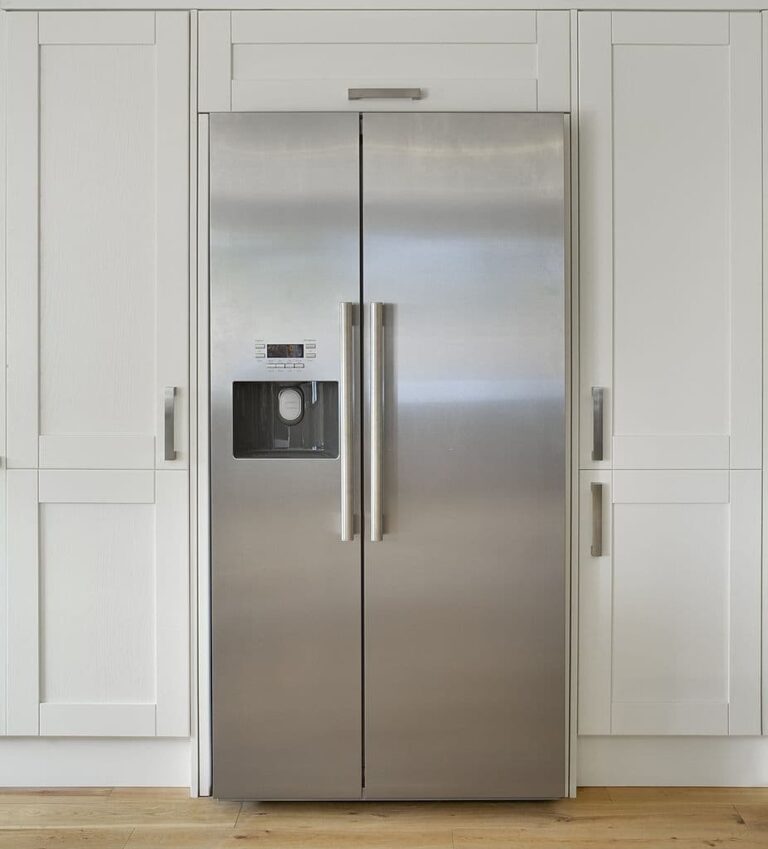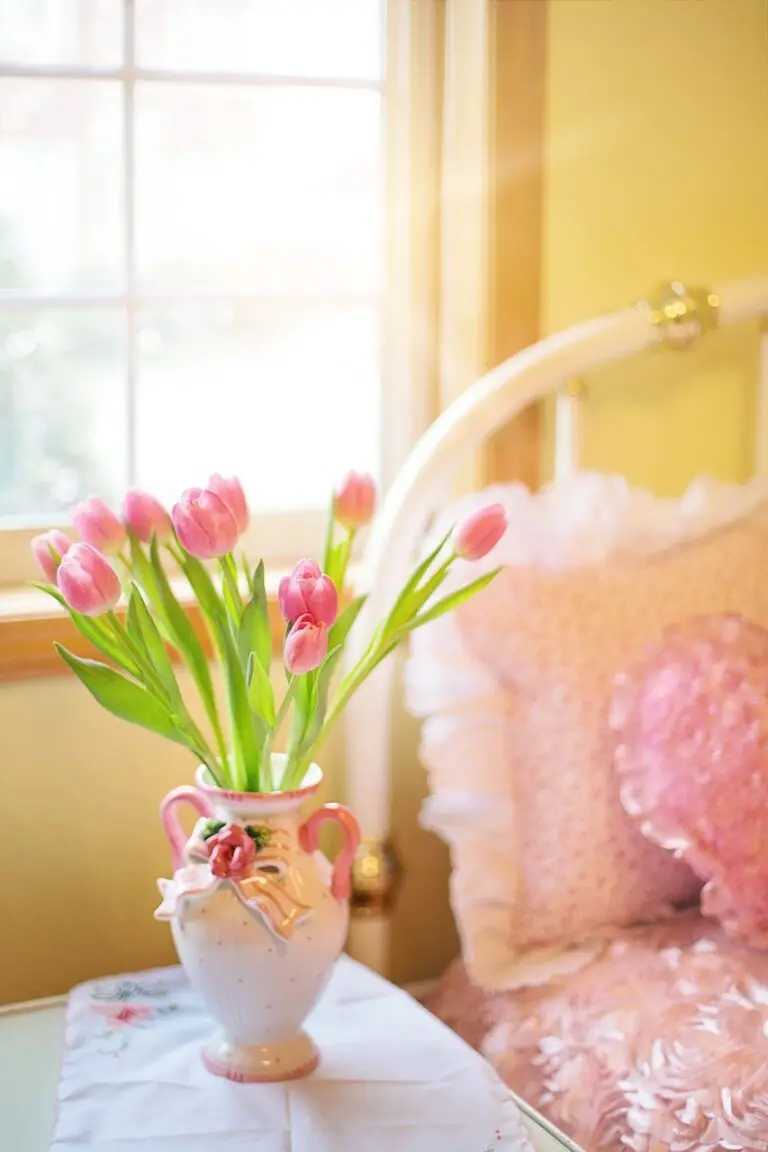20 Small Bathroom Lighting Ideas And Designs (With Pictures)
When it comes to making a small bathroom appear more spacious, one of the most effective strategies is to incorporate well-designed lighting. In this article, we’ll delve into 20 different types of lighting that can help brighten up your space and make it feel more inviting. We’ll also provide valuable tips on how to select the right type of lighting for your specific needs.
Whether you’re embarking on a full-scale renovation or simply seeking a quick fix, this guide will offer a wealth of ideas for illuminating your small bathroom. To start, consider installing a frameless mirror to conserve space and add visual depth. Mounting the mirror high on the wall can also create the illusion of vertical space. Additionally, task or accent lighting can be used to highlight specific areas of the bathroom, such as around the sink or near the shower.
This can help draw attention away from the bathroom’s compact dimensions. In terms of vanity lighting, options include wall-mounted fixtures, sconces, and chandeliers or pendants. Recessed lighting is another great choice for small bathrooms, as it provides even illumination without taking up too much space. Installing recessed lights around the mirror can also make it easier to apply makeup or shave, while placing them near the shower or bathtub can create a relaxing atmosphere.
When choosing LED bulbs for your recessed lights, be sure to select energy-efficient options that will last longer and reduce your environmental impact. Another important consideration is task lighting – installing a light above the sink or next to the toilet can provide focused illumination for reading or grooming. Ultimately, the key to successfully lighting a small bathroom is finding a balance between ambient, task, and accent lighting.
With so many different options available, it’s easy to get overwhelmed. However, by considering your specific needs and preferences, you can create a well-lit space that feels spacious and inviting.
Small bathroom mirror and lighting ideas
Consider a frameless mirror to save space
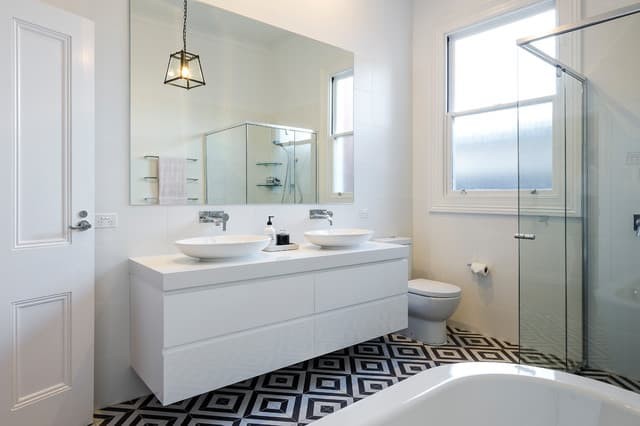
When it comes to maximizing space in your home, a frameless mirror is an excellent option. Unlike traditional mirrors with bulky frames, frameless mirrors are simply a sheet of glass with an adhesive backing that can be applied directly to any wall. This innovative design not only saves space but also allows for easy removal when cleaning or updating the look of your home.
The seamless integration with surrounding surfaces makes it perfect for creating a sense of openness and airiness in any room.
Mount the mirror high on the wall to add vertical space
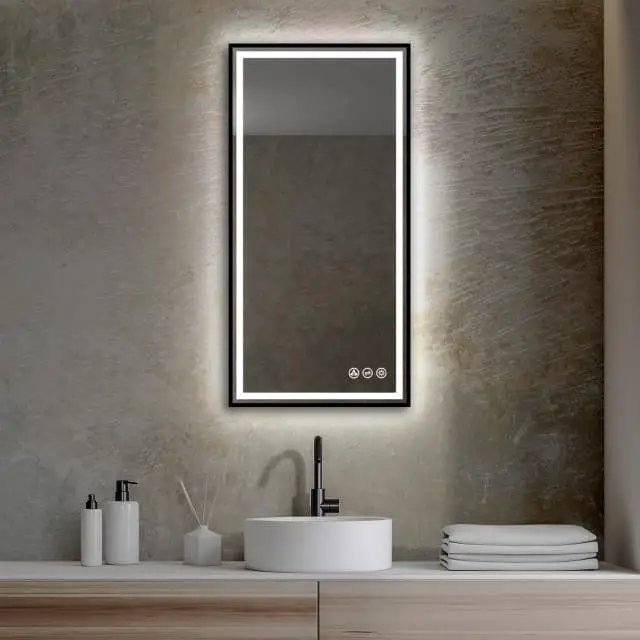
While mirrors are often touted as the magic solution for making small spaces appear larger, there’s more to it than just slapping one up on the wall. In reality, strategically placing a mirror can have a profound impact on the room’s perception of size. By mounting it high on the wall, you’re adding vertical depth and creating an illusion of openness that can make even the most compact spaces feel more expansive.
But that’s not all – when placed opposite a window, a mirror becomes a natural light amplifier, bouncing sunlight around the room and banishing any dark corners. So if you’re looking to create the illusion of a larger space without breaking out the heavy artillery, start by hanging your mirror high and letting it do its magic.
Use task or accent lighting to brighten up specific areas of the bathroom
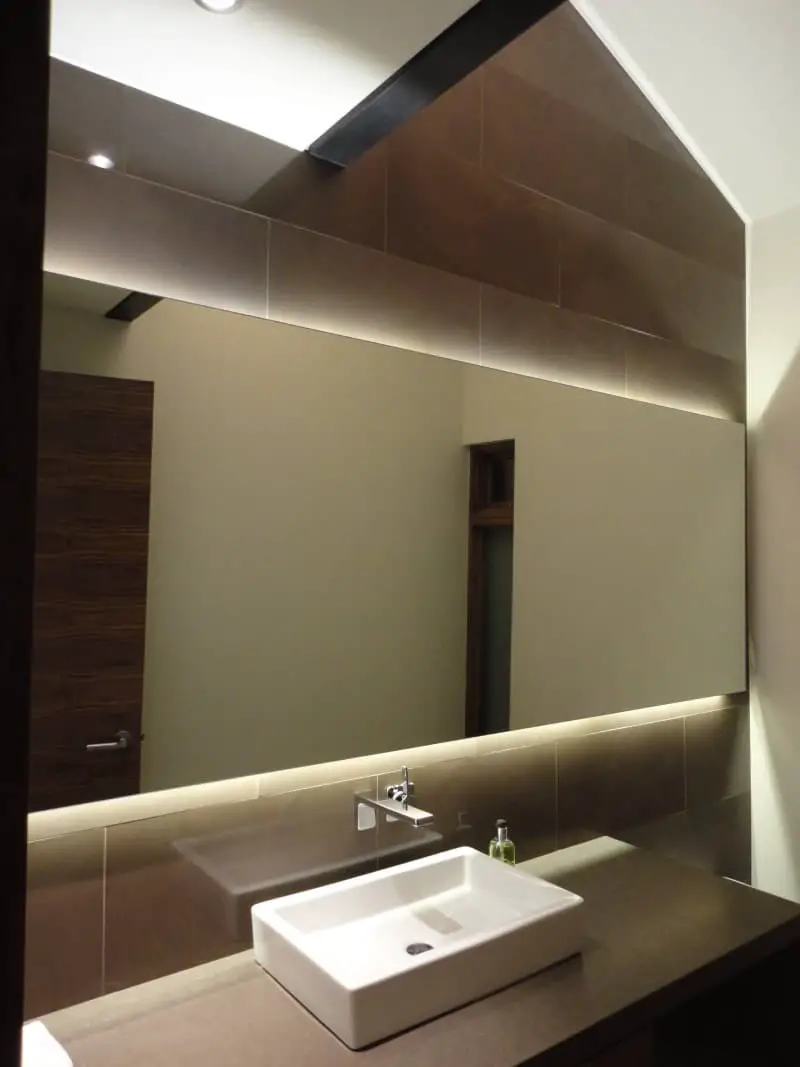
When it comes to bathroom illumination, there are multiple ways to go about it. A common strategy is to employ task lighting, which focuses on illuminating particular zones where you need it most. This approach can be applied to spotlighting the sink area for tasks like shaving or applying makeup, providing a precise and adjustable light source.
Another option is accent lighting, which creates a calming ambiance in areas like the bathtub or shower, highlighting the space without overpowering the senses. Ultimately, regardless of the method you choose, incorporating task or accent lighting can significantly enhance specific areas of the bathroom, making daily routines more efficient and enjoyable.
Small bathroom vanity lighting ideas
Wall-mounted vanity lighting
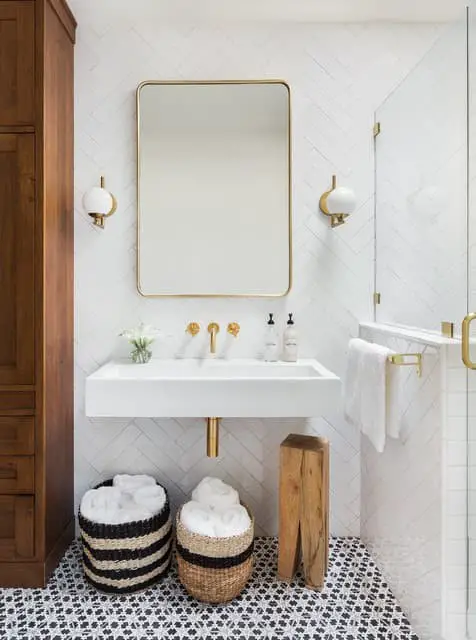
While bathroom lighting is often overlooked, it plays a crucial role in setting the tone for the entire space. One frequently underutilized option is wall-mounted vanity lighting, which offers both aesthetic appeal and functional benefits. By installing these fixtures, you can create task-oriented lighting for everyday activities like makeup application or shaving, while also adding a touch of sophistication to your bathroom’s ambiance.
When selecting wall-mounted vanity lights, be mindful of the fixture size, placement, and light source. LED bulbs are an excellent choice due to their energy efficiency and long lifespan. With the vast array of options available, you’re sure to discover wall-mounted vanity lights that align with your unique needs and style.
Sconce vanity lighting
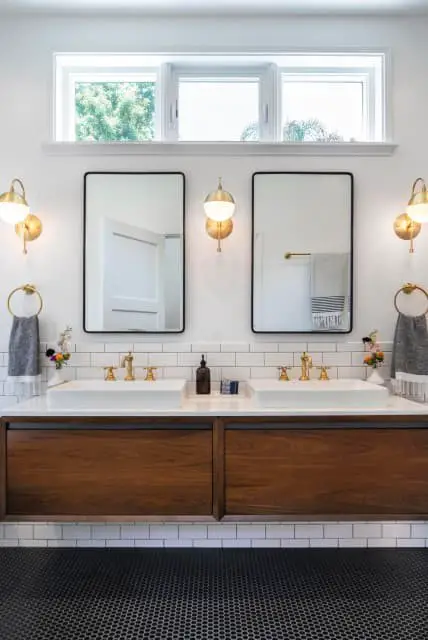
Sconce vanity lighting has become a staple in bathrooms due to its striking visual appeal and practical functionality. Unlike overhead lighting, sconces provide focused illumination that’s perfect for tasks such as applying makeup or shaving, offering precise lighting where it’s needed most. Furthermore, sconce lighting can cleverly create a cozy atmosphere in the bathroom, making it an ideal choice for homeowners seeking to add warmth and ambiance to their space.
When selecting sconce vanity lighting for the bathroom, it’s crucial to opt for fixtures designed specifically for damp areas, as they’ll be crafted from materials resistant to moisture and feature sealed electrical components to ensure safety and longevity. With thoughtful planning, sconce vanity lighting can effortlessly elevate the aesthetic and functionality of any bathroom.
Chandelier or pendant vanity lighting
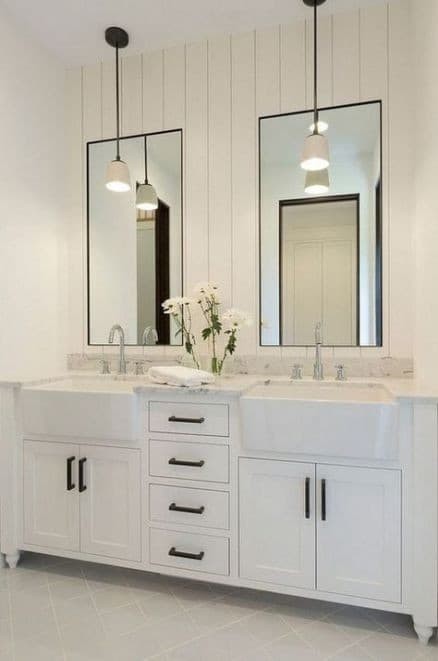
Bathroom vanity lighting offers a plethora of options, each with its own unique character. Chandelier or pendant lighting is a popular choice among homeowners, as it brings an air of sophistication and luxury to the space. Pendant lights are often strategically placed at varying heights to create a visually striking display, while chandeliers typically hang from the ceiling.
This type of lighting can be particularly effective in larger bathrooms, where it can help fill the room with ambiance and create a sense of opulence. When selecting this style of lighting for your bathroom vanity, consider the size of the room and the overall aesthetic you’re aiming to achieve. The key is finding a balance that complements the space while also providing sufficient illumination.
Small bathroom pendant lighting ideas.
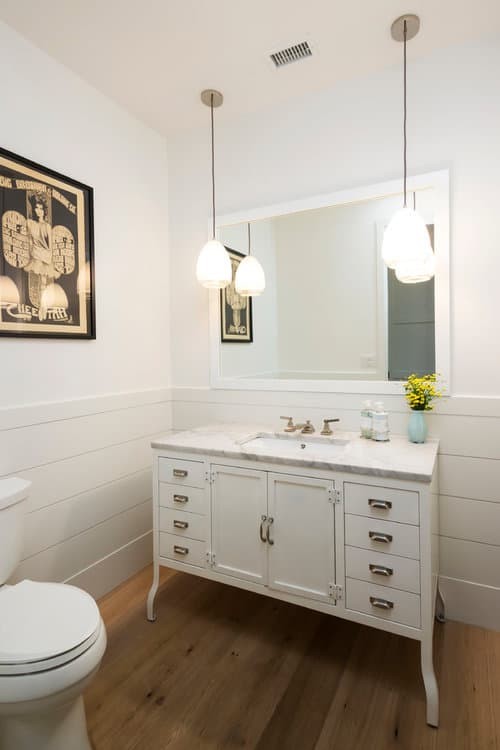
Pendant lighting is an excellent option for bathrooms, as it can dramatically enhance the ambiance and create a sense of warmth. With its ease of installation and wide range of styles, sizes, and designs to choose from, pendant lighting is perfect for small bathrooms. Here are some innovative ideas to consider:
Create a focal point by hanging a striking single-light pendant above your bathroom vanity, adding character to the space.
For a unique display, install multiple small, decorative pendants around mirrors to create an eye-catching arrangement.
Achieve a spa-like atmosphere with a pendant that allows for adjustable height, enabling you to customize the ambient light to suit your needs.
For a subtle and soft ambiance, use two or three large pendants above the tub-shower area.
Alternatively, opt for a long rectangular pendant above your bathroom vanity, spreading light evenly throughout the space.
This is particularly useful when applying makeup or shaving in the morning.
Small bathroom recessed lighting ideas.
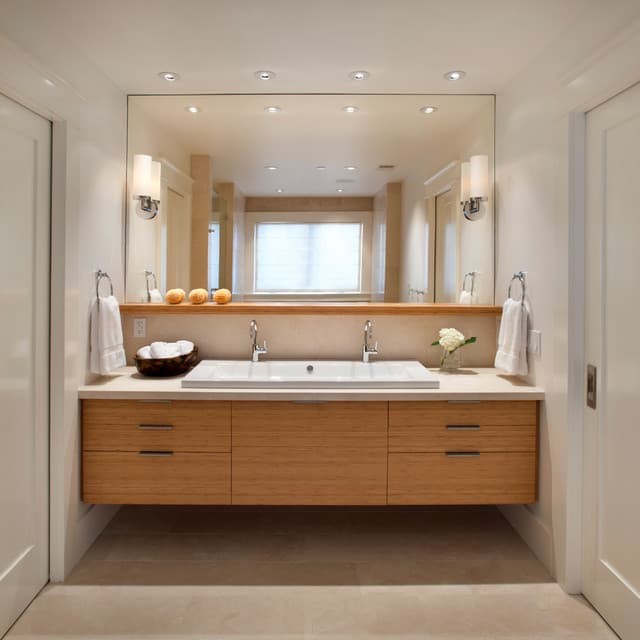
Recessed lighting is a great way to add light to a small bathroom while taking up minimal space
Recessed lighting is often the ideal choice for illuminating a compact bathroom. Unlike conventional floor lamps or table lamps, recessed lights occupy zero visual real estate, creating a streamlined and uncluttered ambiance by virtue of their flush installation with the ceiling. Furthermore, this type of lighting is incredibly versatile, allowing you to craft a range of distinct atmospheres.
For instance, installing dimmers enables the creation of a soothing, relaxing atmosphere, while employing different colored bulbs injects a dash of personal flair into the space. Regardless of your specific needs or aesthetic preferences, recessed lighting proves an exemplary means of introducing light to a small bathroom.
There are many different types of recessed lighting that can be used in a bathroom, so choose the ones that will work best for your needs
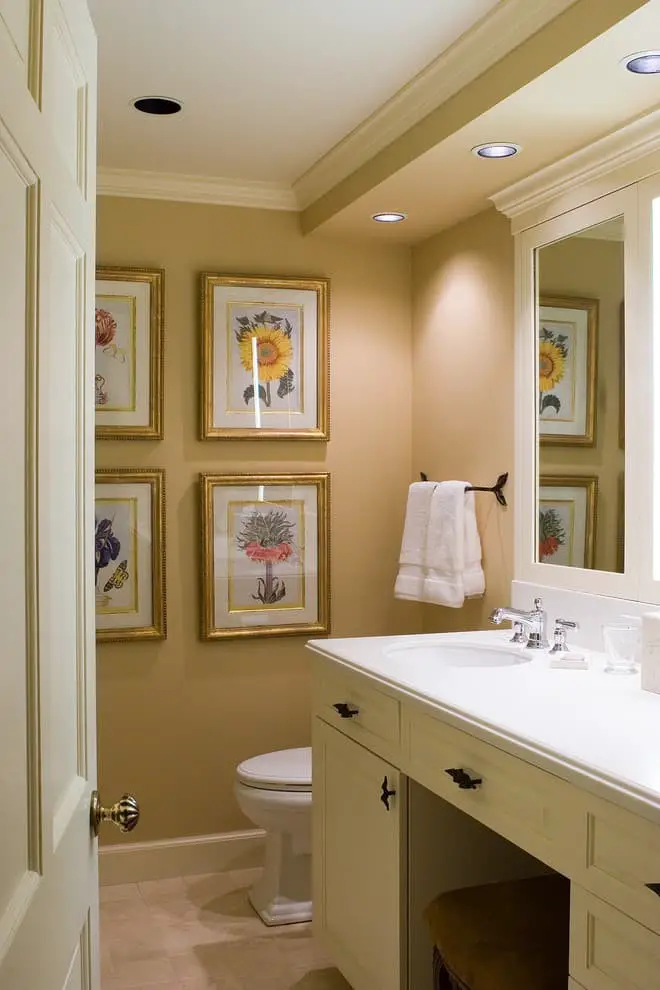
When selecting recessed lighting for a bathroom, several factors come into play. Initially, consider the type of lightbulb you prefer. LED bulbs are a popular choice due to their longer lifespan and reduced heat emission compared to traditional incandescent bulbs, although they may be more costly upfront. Halogen bulbs are another energy-efficient option. However, the size of your bathroom is likely the most significant consideration in choosing recessed lighting.
For small spaces, selecting smaller lights ensures the room doesn’t feel overwhelmed, while larger bathrooms can accommodate bigger lights without feeling overpowering. Ultimately, finding the right combination of size and type for your bathroom’s unique needs is crucial to achieving a well-lit space that meets your requirements.
Install recessed lighting around the mirror to help you see better when applying makeup or shaving
For many of us, the bathroom is the first room we encounter upon waking up, setting the tone for our day ahead. Ideally, this space should exude calmness and serenity, providing a peaceful sanctuary to begin our morning routine. Unfortunately, subpar lighting can hinder our daily tasks, such as applying makeup or shaving, leading to a stressful start to the day. Recessed lighting around the mirror offers an effortless solution to this common issue.
By focusing light directly on your face, it simplifies the process of grooming and reduces visual discomfort. Moreover, recessed lighting allows for creative expression in bathroom design, enabling you to select from a range of colors and finishes that harmonize with your personal style. If you’re seeking a straightforward way to enhance your bathroom’s ambiance, consider installing recessed lighting around your mirror, yielding a more inviting space that fosters a sense of relaxation.
Place recessed lights near the shower or bathtub to create a relaxing atmosphere
Stepping out of the shower or tub after a long day can be a serene experience, but harsh overhead lights in most bathrooms can quickly shatter the calm. The good news is that there’s a simple way to create a more relaxing ambiance: installing recessed lighting near the shower or tub. This soft, diffused light adds a warm and inviting glow to the space, making it perfect for unwinding after a long day.
Not only does this type of lighting create a spa-like atmosphere, but it’s also safe to use in wet areas, eliminating concerns about water damage. Whether you’re looking to enhance your morning routine or transform your bathroom into a retreat from the world, recessed lighting is an ideal solution.
Make sure to use LED bulbs in your recessed lights for energy efficiency and longer life spans
When it comes to enhancing the ambiance and functionality of your small bathroom, recessed lighting can be a fantastic solution. While traditional incandescent bulbs may provide adequate illumination, they often come with significant energy consumption and limited lifespan issues. In contrast, LED bulbs offer a more efficient and long-lasting alternative that can help reduce energy bills while also ensuring safer operation in recessed fixtures due to their minimal heat production.
To incorporate recessed lighting into your small bathroom design, consider the following applications:Task Lighting: Strategically place recessed fixtures around the sink or shower area to provide focused, direct light ideal for grooming and makeup application. Accent Lighting: Create a warm and inviting atmosphere by placing recessed lights along walls at varying heights, producing an interesting lighting effect that draws attention to specific areas of the room.
Ambient Lighting: If your bathroom lacks natural light, utilize recessed fixtures on the ceiling to create a soft, general illumination that provides a cozy ambiance. Decorative Lighting: Add visual interest and extra light by installing recessed fixtures along mirror edges or around artwork, creating a focal point. You can also frame shower or bathtub areas for a sleek, modern look.
Small bathroom ceiling light ideas.
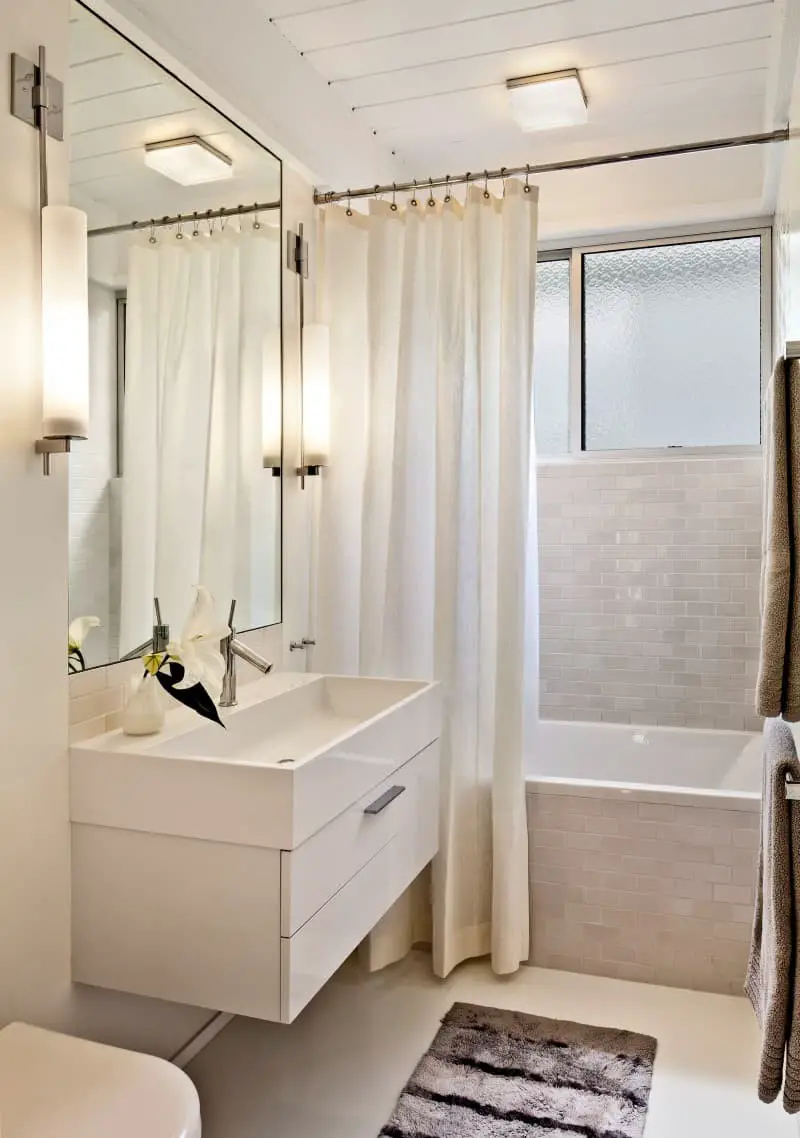
When it comes to lighting up a small bathroom, finding the perfect ceiling light can be a challenge. However, by considering a few key factors, you can ensure that your bathroom is well-lit without feeling cramped. First and foremost, think about scale. Choose fixtures that are proportionate to the size of your bathroom – this will help prevent overwhelming or overpowering the space.
Another approach is to utilize multiple light sources, such as recessed lights and wall sconces, which can provide both general and task lighting. General lighting will illuminate the entire space, while task lighting can be used to highlight specific areas like the sink or tub. Energy efficiency is also an important consideration when selecting bathroom ceiling lights.
Look for fixtures with LED technology, which are not only more efficient but can also help you save money on your electric bill in the long run. Finally, don’t forget about design – choose a light that not only functions well but also looks great and complements your bathroom’s decor.
Best lighting for small bathroom without windows.
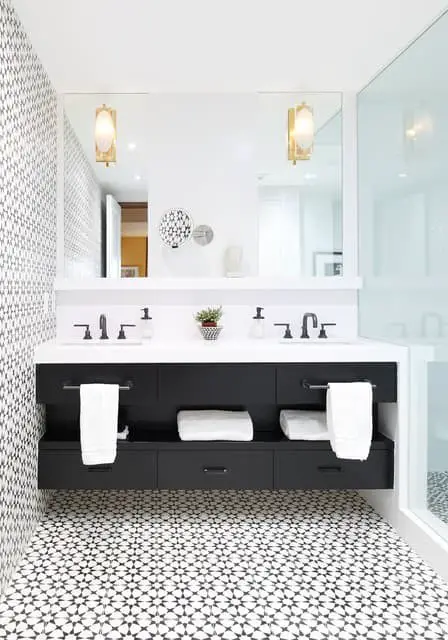
In small bathrooms without windows, the key to creating a sense of spaciousness and brightness lies in strategically layering different types of light sources. This multi-faceted approach to illumination involves combining ambient, task, and accent lighting to achieve a harmonious balance. The primary function of ambient lighting is to provide sufficient overall illumination, ensuring that you can move around safely and comfortably.
Task lighting, on the other hand, serves as a functional necessity for specific activities such as grooming, applying makeup, or simply brushing your teeth. Meanwhile, accent lighting plays a crucial role in drawing attention to prominent features within the bathroom, like a mirror or decorative artwork.
If your bathroom doesn’t have any windows, you’ll need to install some artificial light.
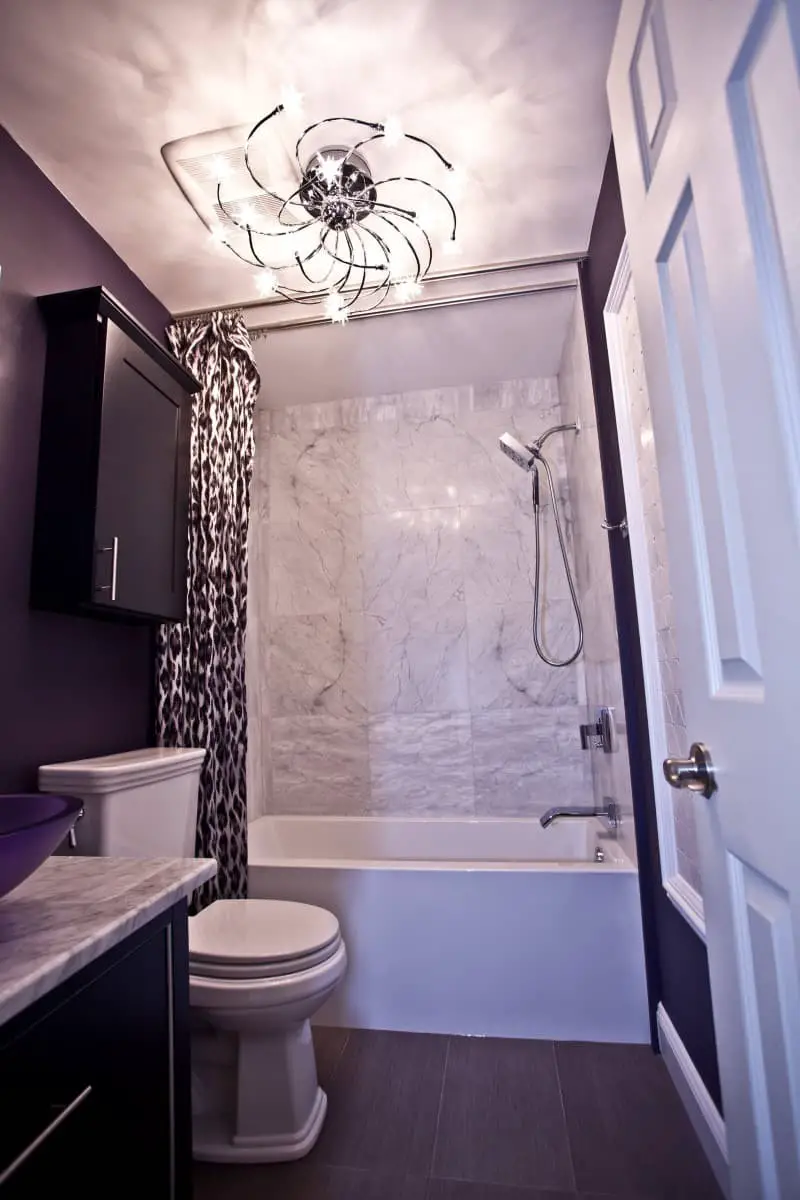
In many bathrooms, natural light pours in through windows, but there are cases where a window is not feasible. If you’re dealing with a windowless bathroom, installing artificial lighting becomes a necessity. A well-designed lighting scheme typically involves combining overhead lighting with task lighting. Overhead lighting provides general illumination, whereas task lighting highlights specific areas such as the sink or shower.
When selecting light fixtures for your damp environment, ensure they are designed specifically for use in humid spaces. With the right lighting, a windowless bathroom can still be both practical and welcoming.
Recessed lighting is a good option because it doesn’t take up much space and provides even illumination.
Recessed lighting is a popular choice when it comes to illuminating a room, offering a sleek and space-efficient solution that provides even coverage throughout the space. One of the primary advantages of recessed lighting is its ease of installation, making it a versatile option for a variety of settings. However, before selecting this type of lighting, there are several factors to consider. First and foremost, ensure that the fixtures you choose are UL-listed for safety purposes.
Additionally, be mindful that recessed lighting does generate heat, so select a fixture that is rated for the room’s temperature conditions. Furthermore, keep in mind that recessed lighting can be more expensive than other options, making it essential to compare prices before making a purchase. By taking these factors into account, you can confidently choose the ideal recessed lighting solution for your needs.
Another option is to install a vanity light above the mirror. Make sure it’s bright enough to see clearly in the mirror.
When designing bathroom lighting, it’s crucial to strike a balance between overall illumination and task-specific lighting. A primary source of light, such as an overhead fixture or wall sconce, should be bright enough to illuminate the entire space. Additionally, a task light positioned near the mirror is essential for clear visibility when grooming or applying makeup.
Installing a vanity light above the mirror is one viable option, ensuring that the area around your face is well-lit and adjustable to suit your preferences. Alternatively, sconces flanking the mirror can provide even lighting, allowing you to fine-tune the brightness level as needed. Ultimately, it’s vital to choose a lighting solution that offers versatility and adaptability to meet your unique needs.
LED lights are a great choice for bathrooms because they’re energy-efficient and last a long time.
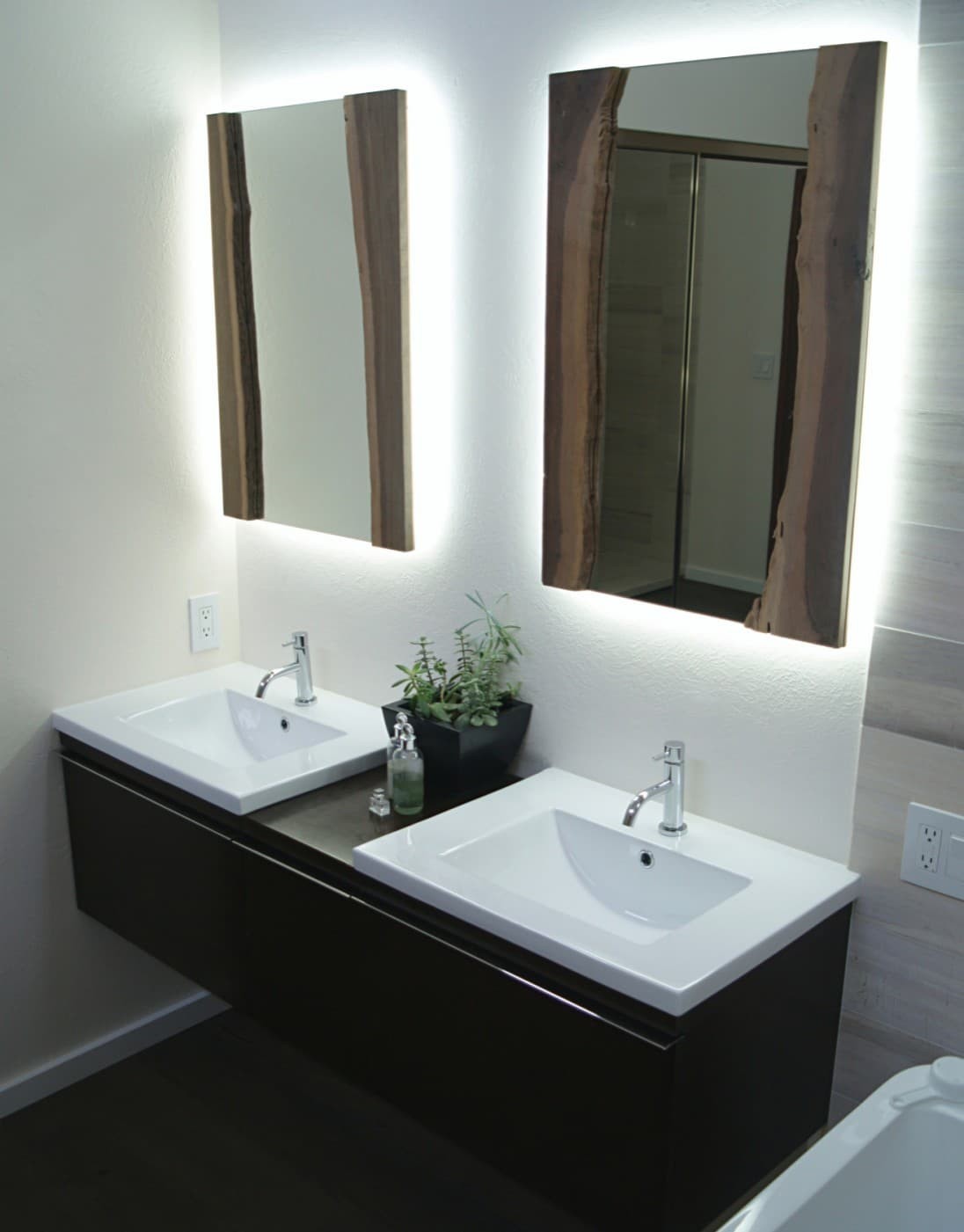
LED lights have gained widespread popularity due to their numerous advantages. Not only do they consume significantly less energy compared to traditional incandescent bulbs, but they also boast an impressive lifespan, making them a cost-effective solution in the long run. Furthermore, LEDs come in a diverse range of colors and temperatures, allowing you to select the perfect lighting scheme for your bathroom.
Their versatility is another major selling point, as they can be used for accent lighting, task lighting, or general illumination purposes. Overall, LED lights offer an efficient and stylish way to illuminate your bathroom.
Don’t forget about task lighting! You may want to install a light over the sink or next to the toilet for reading or grooming.
When it comes to designing a room in your home, lighting is a crucial aspect to consider. Not only does it significantly impact the ambiance and aesthetic of the space, but it also plays a significant role in our daily routines. To create an effective and functional lighting scheme, it’s essential to think about task lighting – a type of illumination that provides focused light for specific activities.
This might involve installing lights above sinks or near toilets to improve visibility while reading or grooming. Task lighting not only enhances the functionality of a room but also helps reduce eye strain and boost productivity. As you plan your next home renovation, make sure to prioritize task lighting to create a space that’s both comfortable and efficient.
How do you light a small bathroom?
Rethinking the lighting in a small bathroom? Start by harnessing the power of recessed lighting! Strategically placed around the room, downlights can create an even, flattering wash of light that’s both bright and unobtrusive. To take it to the next level, supplement with wall sconces or a pendant light for focused task lighting in specific areas. The vanity area is where an illuminated mirror really shines – combining task and ambient lighting in one sleek unit.
And let’s not forget about natural light! Installing a window or skylight can make a world of difference, increasing the brightness of your small bathroom space. By mixing and matching these lighting sources, you’ll be amazed at how effectively you can brighten up and illuminate your tiny oasis.
How many lights should a small bathroom have?
The ideal bathroom lighting configuration hinges on the space’s dimensions and the types of fixtures chosen. Compact bathrooms typically require at least one overhead light, accompanied by task-oriented lighting sources like wall-mounted sconces or linear strips above the vanity to provide focused illumination.
Conversely, larger bathrooms benefit from a tiered approach to lighting, comprising a central ceiling fixture, strategic placement of task lights near mirrors, and accent lighting to draw attention to notable design elements such as artwork or a striking tile backsplash.
What lighting is best for a small bathroom?
To create an inviting ambiance in a small bathroom, it’s crucial to strike the right balance between brightness and warmth. A mix of natural and task lighting sources can work wonders. For instance, installing a skylight or a large window allows for ample natural light, while wall sconces or vanity lights cater to specific tasks like grooming.
Moreover, consider layering light sources such as recessed ceiling lighting, pendants above the vanity, and wall-mounted fixtures to guarantee sufficient illumination. When it comes to bulbs, opt for high-quality options with higher wattage ratings to achieve both brightness and coziness.
To further enhance the overall aesthetic, incorporate dimmer switches into your design for recessed lights and wall sconces, thereby allowing you to effortlessly adjust the lighting levels according to your needs.
Are LED lights OK for bathroom?
LED lights are an excellent option for bathroom illumination, offering a combination of brightness, energy efficiency, and longevity. Their versatility in terms of shape, size, and style allows you to select the perfect aesthetic for your space. Furthermore, LEDs generate minimal heat, making them a safer choice for bathrooms that incorporate water or moisture, eliminating concerns about heat-related hazards.
Perhaps most notably, LEDs can help you save money over time by reducing energy consumption and increasing lifespan compared to other lighting options. Although the initial cost of LEDs may be higher, their superior efficiency will ultimately justify these expenditures.
Conclusion
Regardless of your bathroom’s size or aesthetic, there are numerous ways to incorporate small bathroom lighting ideas that will enhance the space. Soft illumination plays a crucial role in creating a serene ambiance, so opt for fixtures with dimming capabilities whenever possible. Experimenting with varied patterns and textures is another effective means of adding a distinctive touch.
However, it’s essential to remember that the primary consideration when selecting lighting fixtures should be their functionality and visual appeal. By keeping these factors in mind, you can craft a cozy and inviting atmosphere within any size bathroom, making it an ideal retreat for relaxation and self-care.
Related Posts
When it comes to walk-in tubs, safety is paramount for the elderly. Four key features stand out as crucial in ensuring a safe and enjoyable bathing experience. Firstly, a non-slip surface is essential to prevent falls and injuries. This can be achieved through textured surfaces or anti-slip coatings. Secondly, grab bars and handrails provide additional support and stability, allowing users to confidently enter and exit the tub.
Thirdly, a low threshold or gradual entrance reduces the risk of tripping or stumbling. Finally, a comfortable and accessible seating area allows users to sit back and relax while bathing. In addition to these features, it’s also important to consider the etiquette and considerations surrounding tipping for services like Christmas light installation. For instance, it’s generally acceptable to tip 10-15% for good service.
On a related note, becoming a kitchen and bath designer can be a rewarding career pathway. To get started, one might consider obtaining certifications from professional organizations or participating in online courses. Similarly, becoming a lighting designer requires a comprehensive understanding of the subject matter. A key part of this process is developing an essential guide that covers topics such as color theory and lighting principles.
In the realm of bathroom design, exploring alternative coverings for walls beyond traditional tiles can lead to unique and exciting results. For instance, using reclaimed wood or glass can add visual interest and personality to a space. Finally, there’s no reason why DIY enthusiasts can’t get in on the holiday decorating action. Crafting ideas like mason jar lighting creations can bring a touch of rustic charm to any room.




